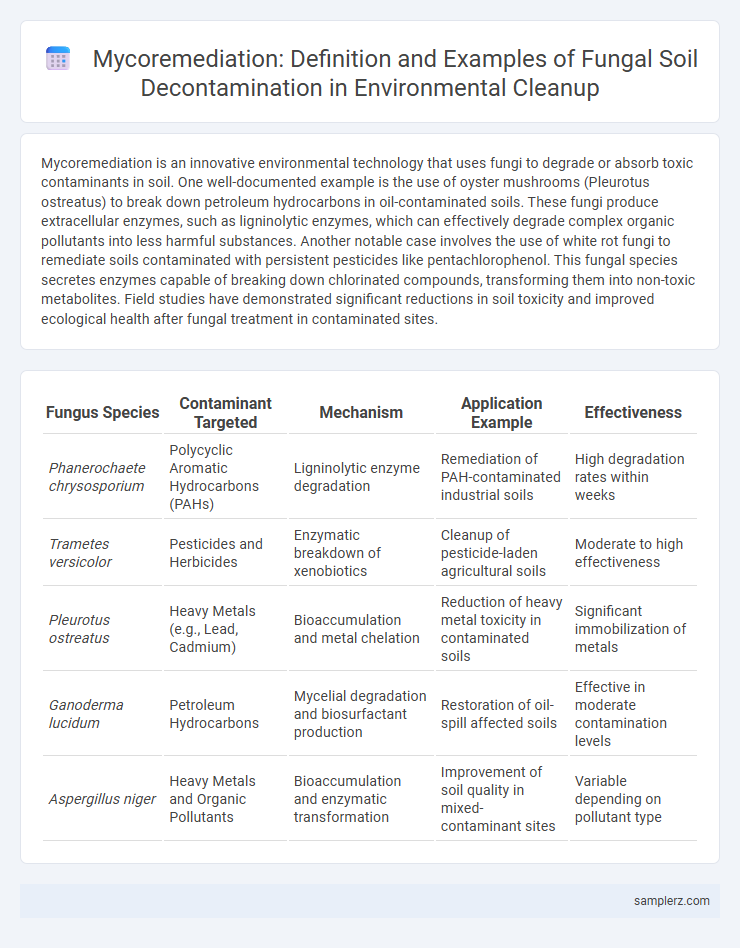Mycoremediation is an innovative environmental technology that uses fungi to degrade or absorb toxic contaminants in soil. One well-documented example is the use of oyster mushrooms (Pleurotus ostreatus) to break down petroleum hydrocarbons in oil-contaminated soils. These fungi produce extracellular enzymes, such as ligninolytic enzymes, which can effectively degrade complex organic pollutants into less harmful substances. Another notable case involves the use of white rot fungi to remediate soils contaminated with persistent pesticides like pentachlorophenol. This fungal species secretes enzymes capable of breaking down chlorinated compounds, transforming them into non-toxic metabolites. Field studies have demonstrated significant reductions in soil toxicity and improved ecological health after fungal treatment in contaminated sites.
Table of Comparison
| Fungus Species | Contaminant Targeted | Mechanism | Application Example | Effectiveness |
|---|---|---|---|---|
| Phanerochaete chrysosporium | Polycyclic Aromatic Hydrocarbons (PAHs) | Ligninolytic enzyme degradation | Remediation of PAH-contaminated industrial soils | High degradation rates within weeks |
| Trametes versicolor | Pesticides and Herbicides | Enzymatic breakdown of xenobiotics | Cleanup of pesticide-laden agricultural soils | Moderate to high effectiveness |
| Pleurotus ostreatus | Heavy Metals (e.g., Lead, Cadmium) | Bioaccumulation and metal chelation | Reduction of heavy metal toxicity in contaminated soils | Significant immobilization of metals |
| Ganoderma lucidum | Petroleum Hydrocarbons | Mycelial degradation and biosurfactant production | Restoration of oil-spill affected soils | Effective in moderate contamination levels |
| Aspergillus niger | Heavy Metals and Organic Pollutants | Bioaccumulation and enzymatic transformation | Improvement of soil quality in mixed-contaminant sites | Variable depending on pollutant type |
Introduction to Mycoremediation in Soil Decontamination
Mycoremediation utilizes fungi species like Pleurotus ostreatus and Phanerochaete chrysosporium to degrade persistent soil pollutants such as polycyclic aromatic hydrocarbons (PAHs) and heavy metals. These fungi secrete enzymes including lignin peroxidase and manganese peroxidase that break down complex organic contaminants into less toxic compounds. Research demonstrates significant reductions in soil toxicity and improved ecological health through mycoremediation techniques, highlighting their potential for sustainable soil decontamination.
Key Fungal Species Used for Mycoremediation
Key fungal species used for mycoremediation in soil decontamination include Pleurotus ostreatus, known for its ability to degrade petroleum hydrocarbons, and Phanerochaete chrysosporium, which effectively breaks down lignin and various organic pollutants. Trametes versicolor is also widely studied for its enzymatic capacity to detoxify heavy metals and synthetic dyes in contaminated soils. These fungi employ extracellular enzymes such as lignin peroxidase and manganese peroxidase to transform toxic compounds into less harmful substances, facilitating soil restoration.
Mechanisms of Soil Contaminant Breakdown by Fungi
Fungi degrade soil contaminants through enzymatic processes involving ligninolytic enzymes such as laccases, peroxidases, and manganese peroxidases that break down complex organic pollutants into less toxic compounds. Mycelial networks facilitate the penetration and colonization of contaminated soil, increasing the bioavailability of pollutants for enzymatic action. The metabolic pathways employed by fungi also enable the transformation of heavy metals and hydrocarbons, enhancing soil detoxification and restoring microbial balance.
Case Study: Mycoremediation of Petroleum Hydrocarbons
Mycoremediation of petroleum hydrocarbons involves using specialized fungi such as white rot fungi (Phanerochaete chrysosporium) to degrade toxic hydrocarbons in contaminated soils. Studies demonstrate that these fungi produce ligninolytic enzymes like laccase and manganese peroxidase, which break down complex hydrocarbon pollutants into less harmful substances. In one case study, contaminated soil with petroleum residues showed a reduction in total petroleum hydrocarbons by over 70% within 60 days of fungal treatment, highlighting the potential of mycoremediation for effective soil decontamination.
Application in Heavy Metal Remediation
Mycoremediation effectively utilizes fungi such as Pleurotus ostreatus and Phanerochaete chrysosporium to adsorb and transform heavy metals like cadmium, lead, and mercury in contaminated soils. These fungal species produce enzymes and metabolites that bind, precipitate, or degrade toxic metals, reducing bioavailability and toxicity. Field studies demonstrate significant decreases in heavy metal concentration and improved soil health, highlighting mycoremediation as a sustainable and eco-friendly approach for soil decontamination.
Mycoremediation for Agricultural Pesticide Cleanup
Mycoremediation utilizes fungi such as white rot fungi to effectively degrade persistent agricultural pesticides like chlorpyrifos and atrazine in contaminated soils. These fungi produce ligninolytic enzymes that break down complex pesticide molecules into non-toxic byproducts, enhancing soil health and reducing environmental risks. Field studies demonstrate significant reductions in pesticide concentration, promoting sustainable agricultural practices and safer crop production.
Bioremediation of Organic Pollutants Using Fungi
Mycoremediation employs fungi such as white-rot fungi (Phanerochaete chrysosporium) to degrade organic pollutants like polycyclic aromatic hydrocarbons (PAHs) in contaminated soils. These fungi secrete ligninolytic enzymes including laccases and peroxidases that break down complex hydrocarbons into less toxic compounds. Studies have demonstrated significant reductions in soil toxicity and pollutant concentration through fungal bioremediation, highlighting its potential as an eco-friendly soil decontamination strategy.
Field Trials Demonstrating Mycoremediation Success
Field trials in mycoremediation have shown significant success in decontaminating soils polluted with hydrocarbons and heavy metals. For example, Pleurotus ostreatus cultivated in petroleum-contaminated sites effectively degraded polycyclic aromatic hydrocarbons (PAHs), resulting in a 60-80% reduction of toxic compounds within several months. These trials demonstrate the potential of fungi-based remediation to restore soil health and reduce environmental hazards in situ.
Advantages and Limitations of Mycoremediation
Mycoremediation employs fungi to degrade or immobilize soil contaminants, offering eco-friendly and cost-effective cleanup of heavy metals, pesticides, and hydrocarbons. The advantages include high efficiency in breaking down complex pollutants, minimal disruption to the soil ecosystem, and the ability to target a wide range of contaminants. Limitations involve slower degradation rates compared to chemical methods, sensitivity to environmental conditions, and potential challenges in scaling up for large contaminated sites.
Future Perspectives in Fungal Soil Decontamination
Future perspectives in fungal soil decontamination emphasize the integration of genetically engineered fungi with enhanced enzymatic pathways targeting complex pollutants such as polycyclic aromatic hydrocarbons (PAHs) and heavy metals. Advances in omics technologies enable the identification and optimization of fungal strains with superior biodegradation capabilities, potentially accelerating remediation timelines. Scaling up mycoremediation techniques through bioaugmentation and soil amendment innovations could revolutionize sustainable soil health restoration on contaminated sites worldwide.

example of mycoremediation in soil decontamination Infographic
 samplerz.com
samplerz.com